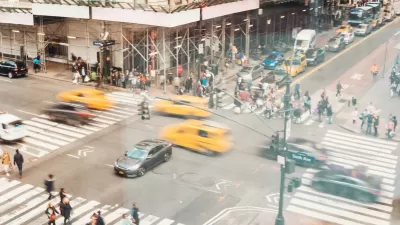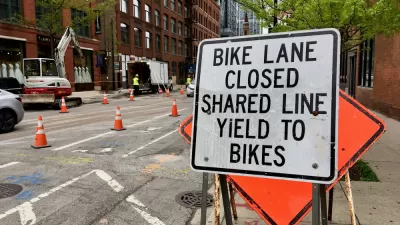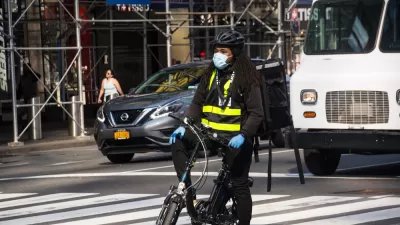The program’s outcomes in different cities show varying levels of success and some failures.

Laura Laker takes a closer look at Vision Zero, a traffic safety program designed to decrease, and ultimately eliminate, traffic deaths and injuries. In 2014, New York was the first large American city to adopt a Vision Zero program. The city lowered traffic speeds on particularly dangerous streets, installed features that slowed traffic, and put in speed cameras. Road fatalities decreased by over 25 percent and pedestrian deaths by almost 50 percent by 2017.
Los Angeles, on the other hand, ran into problems when it started up a Vision Zero program last year, and road fatalities eventually increased by 80 percent, reports Laker:
On Temple Street, where 34 people were killed or severely injured within 2.3 miles in eight years, a “road diet” expected to reduce crashes by up to 47% met backlash from residents and drivers. Local city leaders downgraded lane removals to things that wouldn’t interfere with motor traffic: sidewalk repairs, new traffic signals and crosswalks.
London recently adopted its own Vision Zero plan, and it is also facing resistance. “In June, mayor Sadiq Khan’s flagship pedestrian safety scheme, the pedestrianisation of Oxford Street, was blocked by the local borough, Westminster city council, following local concerns about traffic displacement,” says Laker.
Advocates say Vision Zero programs need strong political leadership to push through the kinds of infrastructure and design changes necessary for creating a safer urban landscape. In addition, policing needs to focus more on drivers and less on pedestrians and cyclists, they say.
FULL STORY: Vision Zero: has the drive to eliminate road deaths lost its way?

Alabama: Trump Terminates Settlements for Black Communities Harmed By Raw Sewage
Trump deemed the landmark civil rights agreement “illegal DEI and environmental justice policy.”

Study: Maui’s Plan to Convert Vacation Rentals to Long-Term Housing Could Cause Nearly $1 Billion Economic Loss
The plan would reduce visitor accommodation by 25% resulting in 1,900 jobs lost.

Planetizen Federal Action Tracker
A weekly monitor of how Trump’s orders and actions are impacting planners and planning in America.

Waymo Gets Permission to Map SF’s Market Street
If allowed to operate on the traffic-restricted street, Waymo’s autonomous taxis would have a leg up over ride-hailing competitors — and counter the city’s efforts to grow bike and pedestrian on the thoroughfare.

Parklet Symposium Highlights the Success of Shared Spaces
Parklets got a boost during the Covid-19 pandemic, when the concept was translated to outdoor dining programs that offered restaurants a lifeline during the shutdown.

Federal Homelessness Agency Places Entire Staff on Leave
The U.S. Interagency Council on Homelessness is the only federal agency dedicated to preventing and ending homelessness.
Urban Design for Planners 1: Software Tools
This six-course series explores essential urban design concepts using open source software and equips planners with the tools they need to participate fully in the urban design process.
Planning for Universal Design
Learn the tools for implementing Universal Design in planning regulations.
Caltrans
Smith Gee Studio
Institute for Housing and Urban Development Studies (IHS)
City of Grandview
Harvard GSD Executive Education
Toledo-Lucas County Plan Commissions
Salt Lake City
NYU Wagner Graduate School of Public Service





























